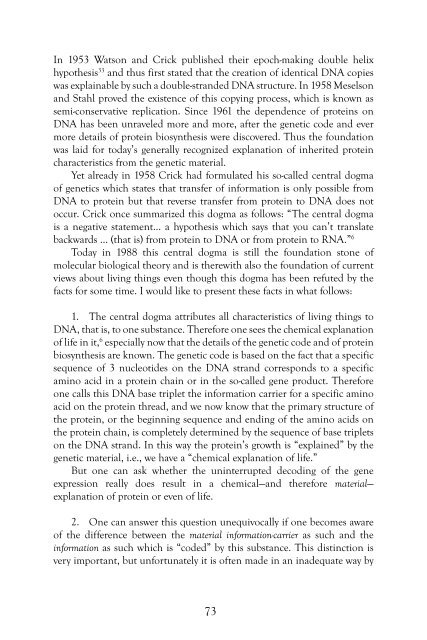When Healing Becomes Educating, Vol. 1 - Waldorf Research Institute
When Healing Becomes Educating, Vol. 1 - Waldorf Research Institute
When Healing Becomes Educating, Vol. 1 - Waldorf Research Institute
Create successful ePaper yourself
Turn your PDF publications into a flip-book with our unique Google optimized e-Paper software.
In 1953 Watson and Crick published their epoch-making double helix<br />
hypothesis 33 and thus first stated that the creation of identical DNA copies<br />
was ex plainable by such a double-stranded DNA structure. In 1958 Meselson<br />
and Stahl proved the existence of this copying process, which is known as<br />
semi-conservative replication. Since 1961 the dependence of proteins on<br />
DNA has been unraveled more and more, after the genetic code and ever<br />
more details of protein biosynthesis were discovered. Thus the foundation<br />
was laid for today’s generally recognized explanation of inherited protein<br />
characteristics from the genetic material.<br />
Yet already in 1958 Crick had formulated his so-called central dogma<br />
of genetics which states that transfer of information is only possible from<br />
DNA to protein but that reverse transfer from protein to DNA does not<br />
occur. Crick once summarized this dogma as follows: “The central dogma<br />
is a negative statement... a hypothesis which says that you can’t translate<br />
backwards ... (that is) from protein to DNA or from protein to RNA.” 6<br />
Today in 1988 this central dogma is still the foundation stone of<br />
molecular biological theory and is therewith also the foundation of current<br />
views about living things even though this dogma has been refuted by the<br />
facts for some time. I would like to present these facts in what follows:<br />
1. The central dogma attributes all characteristics of living things to<br />
DNA, that is, to one substance. Therefore one sees the chemical explanation<br />
of life in it, 6 especially now that the details of the genetic code and of protein<br />
biosynthesis are known. The genetic code is based on the fact that a specific<br />
sequence of 3 nucleotides on the DNA strand corresponds to a specific<br />
amino acid in a protein chain or in the so-called gene product. Therefore<br />
one calls this DNA base triplet the information carrier for a specific amino<br />
acid on the protein thread, and we now know that the primary structure of<br />
the protein, or the beginning sequence and ending of the amino acids on<br />
the protein chain, is completely determined by the sequence of base triplets<br />
on the DNA strand. In this way the protein’s growth is “explained” by the<br />
genetic material, i.e., we have a “chemical explanation of life.”<br />
But one can ask whether the uninterrupted decoding of the gene<br />
expression really does result in a chemical—and therefore material—<br />
explanation of protein or even of life.<br />
2. One can answer this question unequivocally if one becomes aware<br />
of the difference between the material information-carrier as such and the<br />
infor mation as such which is “coded” by this substance. This distinction is<br />
very important, but unfortunately it is often made in an inadequate way by<br />
73

















